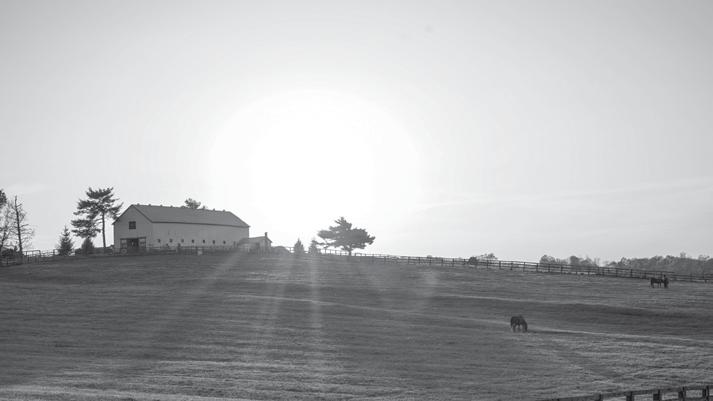HORSE OF THE ISSUE:
SIR BARTON by E R I C
F LOY D
Sir Barton’s Lifetime Statistics:
Year Starts Wins Seconds Thirds Earnings Lifetime 31 13 6 5 $116,857 PHOTO COURTESY OF WIKIPEDIA
While he might have skipped off into eternity with the rarefied title of, “Thoroughbred Horse Racing’s First Triple Crown Champion”, Sir Barton also knew what it was like to “travel through the valley”. Beaten a combined fifty-seven lengths in his first four starts, the most famous son of Star Shoot was then curiously purchased in August of 1918 by a retired Canadian navel veteran named Commander J.K.L Ross for $10,000 (that’s approximately $150,000 in today’s money)! Following a sixteenth-place finish in Saratoga’s prestigious Hopeful Stakes, Sir Barton then “shocked the world” by scoring a silver medal at odds of 15-1 in Belmont Park’s famed Futurity Stakes. On New Year’s Day in 1919, Commander J.K.L. Ross passionately resolved to win the forthcoming Kentucky Derby with his barn’s ace; a big bay gelding named Billy Kelly. On paper at least, Billy Kelly’s primary nemesis was a horse named Eternal and since this one-dimensional racer habitually seized command early, Commander J.K.L. Ross and H.G. Bedwell (Sir Barton’s Hall of Fame trainer) resourcefully reached into their bottomless bag of tricks. Hare-footed in his own right, Sir Barton was therefore entered into the “Run for the Roses” with the ulterior motive of luring Eternal into a suicidal speed duel, one which would (in theory) “set up” the late closing Billy Kelly. In accordance with Ross’ and Bedwell’s strategy, Johnny Loftus (Sir Barton’s hardboiled jockey) immediately opened up on his eleven Derby foes once the flag fell, yet it was soon evident that Eternal didn’t much like Churchill Downs’ “muddy going”. Alas, the day’s theoretic breakneck pace never developed. Instead, Sir Barton prevailed by five lengths in wire to wire fashion over Billy Kelly (who still closed gamely for runner-up
honors despite an unfavorable trip). As for Eternal’s fate, well, to the dismay of many punters who had gone “all-in”, the post-time favorite wound up staggering home in tenth position, beaten some thirty lengths.
1930! This was when a New York Times journalist named Bryan Field wrote about (and popularized) the “Triple Crown” that Gallant Fox had procured for Belair Stud President, William Woodward Sr.
Although he was initially tagged a “one hit wonder” who’d been excessively aided by an “off track”, Sir Barton was just getting started. Back in action just four days after leaving Louisville (this time over a lightning “fast” strip), Commander J.K.L. Ross’ crotchety upstart went on to silence his many naysayers by outrunning an accomplished Preakness field (one which included Eternal) by four lengths. Ultimately exiting Pimlico Race Course (the home of the Preakness) as thoroughbred racing’s most popular equine, Sir Barton then won the Withers Stakes ahead of bagging the Belmont Stakes at the expense of two hopelessly overmatched rivals.
Emulating a “busy little bee” behind his Belmont Stakes triumph, Sir Barton subsequently ran nine more times as a three-year old! Ultimately procuring mixed results with regards to penetrating the winners’ enclosure, Commander J.K.L. Ross’ luminary nevertheless “hit the board”. Netting nearly $90k as a three-year old, Sir Barton likewise “out earned” an up and coming juvenile star named Man o’ War over the course of that interval known as 1919.
Now it is important to note how the complexion of Thoroughbred Horse Racing’s Triple Crown Series has changed over the last century. You see presently, there is a two week gap between the Kentucky Derby and Preakness Stakes, however because the Triple Crown didn’t formally exist in 1919, Sir Barton only had a four day hiatus between those two routes which traditionally highlight the month of May. The fact that Sir Barton also competed in-between his Preakness and Belmont Starts is another incongruity that you would never witness today. So, Sir Barton’s 1919 Kentucky Derby, Preakness and Belmont sweep wasn’t initially characterized a “Triple Crown” Championship. The truth is (drum roll), American horse racing’s most regal heading really did not even surface until the year
Sent post-ward a total of twelve times in 1920, Sir Barton conclusively compiled a résumé which featured five blue ribbons and one world record time (1:55 3/5) for 9 ½ furlongs on dirt. These achievements were largely overshadowed by what occurred on Oct. 12th at Kenilworth Park Racetrack in Ontario, Canada. The first horse race to be filmed in its entirety, the inaugural 75k Kenilworth Park Gold Cup Handicap was essentially a “match race” between the era’s top two equines; Sir Barton and Man o’ War. Easily bested by seven lengths, (because his perpetually sore hooves didn’t mix with Kenilworth’s unyielding surface) Sir Barton thereafter managed only one second place finish and two third place finishes in the final three races of his career. Though mostly a disappointment at stud, “Thoroughbred Horse Racing’s First Triple Crown Champion” need not be too concerned; for the legacy he forged on the track is as immovable as well, the “Sport of Kings” itself! G A M I N G A N D D E S T I N AT I O N S . C O M |
17







